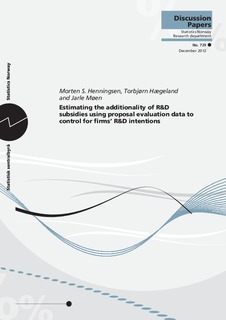Estimating the additionality of R&D subsidies using proposal evaluation data to control for firms’ R&D intentions
| dc.contributor.author | Henningsen, Morten S. | |
| dc.contributor.author | Hægeland, Torbjørn | |
| dc.contributor.author | Møen, Jarle | |
| dc.coverage.spatial | Norway | nb_NO |
| dc.date.accessioned | 2019-11-13T07:18:24Z | |
| dc.date.available | 2019-11-13T07:18:24Z | |
| dc.date.issued | 2012-12 | |
| dc.identifier.issn | 0809-733X | |
| dc.identifier.uri | http://hdl.handle.net/11250/2628014 | |
| dc.description.abstract | Empirical examination of whether R&D subsidies to private firms crowd out private investments has been hampered by problems related to selection. A particular worry is that research intentions and the quality of current research ideas may be correlated with the likelihood of applying for and receiving subsidies. Proposal evaluation data has been put forward as a potential remedy. Using such data from Norway, we do not find strong evidence suggesting that this type of selection creates a severe bias. Proposal evaluation grades strongly predict R&D investments and reduce selection bias in cross-sectional regressions, but there is limited variation in grades within firms over time. This suggests that unobserved project quality is largely absorbed by firm fixed effects. Our best estimate of the short-run additionality of R&D subsidies is 1.15, i.e., a one-unit increase in subsidy increases total R&D expenditure in the recipient firm by somewhat more than a unit. We demonstrate, however, that there is severe measurement error in the subsidy variable. Additionality is therefore likely to be underestimated, and we conclude that measurement errors may be a more important source of bias than selection when panel data are available. | nb_NO |
| dc.description.sponsorship | Research Council of Norway | nb_NO |
| dc.language.iso | eng | nb_NO |
| dc.publisher | Statistisk sentralbyrå | nb_NO |
| dc.relation.ispartofseries | Discussion papers;729 | |
| dc.subject | JEL classification: 38 | nb_NO |
| dc.subject | JEL classification: O32 | nb_NO |
| dc.subject | JEL classification: L53 | nb_NO |
| dc.subject | JEL classification: H25 | nb_NO |
| dc.subject | JEL classification: H32 | nb_NO |
| dc.title | Estimating the additionality of R&D subsidies using proposal evaluation data to control for firms’ R&D intentions | nb_NO |
| dc.type | Working paper | nb_NO |
| dc.description.version | publishedVersion | nb_NO |
| dc.subject.nsi | VDP::Matematikk og Naturvitenskap: 400::Matematikk: 410::Statistikk: 412 | nb_NO |
| dc.source.pagenumber | 36 | nb_NO |
Tilhørende fil(er)
Denne innførselen finnes i følgende samling(er)
-
Discussion Papers [1003]
